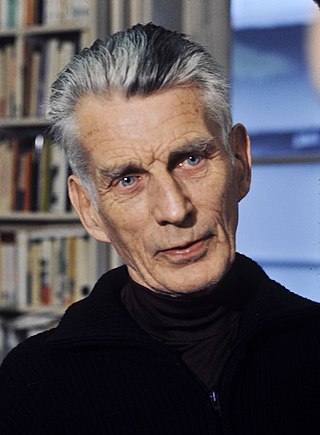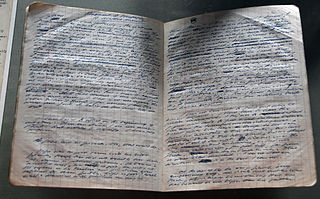
Samuel Barclay Beckett was an Irish novelist, dramatist, short story writer, theatre director, poet, and literary translator. His literary and theatrical work features bleak, impersonal and tragicomic experiences of life, often coupled with black comedy and nonsense. His work became increasingly minimalist as his career progressed, involving more aesthetic and linguistic experimentation, with techniques of stream of consciousness repetition and self-reference. He is considered one of the last modernist writers, and one of the key figures in what Martin Esslin called the Theatre of the Absurd.

Waiting for Godot is a play by Irish playwright Samuel Beckett in which two characters, Vladimir (Didi) and Estragon (Gogo), engage in a variety of discussions and encounters while awaiting the titular Godot, who never arrives. Waiting for Godot is Beckett's translation of his own original French-language play, En attendant Godot, and is subtitled "a tragicomedy in two acts".
Breath is a notably short stage work by Samuel Beckett. An altered version was first included in Kenneth Tynan's revue Oh! Calcutta!, at the Eden Theatre in New York City on 16 June 1969. The UK premiere was at the Close Theatre Club in Glasgow in October 1969; this was the first performance of the text as written. The second performance, and the English premiere, was at a benefit held at the Oxford Playhouse on March 8, 1970. “The first accurate publication appeared in Gambit 4.16 (1969): 5–9, with a manuscript facsimile.”
Play is a one-act play by Samuel Beckett. It was written between 1962 and 1963 and first produced in German as Spiel on 14 June 1963 at the Ulmer Theatre in Ulm-Donau, Germany, directed by Deryk Mendel, with Nancy Illig (W1), Sigfrid Pfeiffer (W2) and Gerhard Winter (M). The first performance in English was on 7 April 1964 at the Old Vic in London. It was not well-received upon its British premiere.
Ohio Impromptu is a "playlet" by Samuel Beckett.

Krapp's Last Tape is a 1958 one-act play, in English, by Samuel Beckett. With a cast of one man, it was written for Northern Irish actor Patrick Magee and first titled "Magee monologue". It was inspired by Beckett's experience of listening to Magee reading extracts from Molloy and From an Abandoned Work on the BBC Third Programme in December 1957.
Rough for Theatre II is a short play by Samuel Beckett. "Although this discarded piece of theatre is dated 'circa 1960' in End and Odds, a manuscript from two years earlier exists in Trinity College, Dublin, Library. This situates a first version, written in French [as Fragment de théâtre II] and different from that eventually published in 1976 as between the English plays Krapp's Last Tape and Embers." It is rarely produced.
What Where is Samuel Beckett's last play produced following a request for a new work for the 1983 Autumn Festival in Graz, Austria. It was written between February and March 1983 initially in French as Quoi où and translated by Beckett himself.
Not I is a short dramatic monologue written in 1972 by Samuel Beckett which was premiered at the "Samuel Beckett Festival" by the Repertory Theater of Lincoln Center, New York.
The Lost Ones is a short story by Samuel Beckett, who abandoned it in 1966 and completed it in 1970. It was then first published in French and translated into English by the author himself the following year.
Quad is a television play by Samuel Beckett, written and first produced and broadcast in 1981. It first appeared in print in 1984 where the work is described as "[a] piece for four players, light and percussion" and has also been called a "ballet for four people."
Rockaby is a short one-woman play by Samuel Beckett. It was written in English in 1980, at the request of Daniel Labeille, who produced it on behalf of Programs in the Arts, State University of New York, for a festival and symposium in commemoration of Beckett's 75th birthday. The play premiered on April 8, 1981, at the State University of New York at Buffalo, starring Billie Whitelaw and directed by Alan Schneider. A documentary film, Rockaby, by D. A. Pennebaker and Chris Hegedus records the rehearsal process and the first performance. This production went on to be performed at the Annex at La MaMa Experimental Theatre Club, and, in December 1982, at the Cottesloe, Royal National Theatre, London.
That Time is a one-act play by Samuel Beckett, written in English between 8 June 1974 and August 1975. The play was specially written for actor Patrick Magee, who delivered its first performance on the occasion of Beckett's seventieth birthday celebration, at London's Royal Court Theatre on 20 May 1976.

Eh Joe is a piece for television, written in English by Samuel Beckett, his first work for the medium. It was begun on the author's fifty-ninth birthday, 13 April 1965, and completed by 1 May. "It [was] followed by six undated typescripts .”

Watt was Samuel Beckett's second published novel in English. It was largely written on the run in the South of France during the Second World War and was first published by Maurice Girodias's Olympia Press in 1953.

From An Abandoned Work, a "meditation for radio" by Samuel Beckett, was first broadcast on BBC Radio 3’s Third Programme on Saturday, 14 December 1957 together with a selection from the novel Molloy. Donald McWhinnie, who already had a great success with All That Fall, directed the Irish actor Patrick Magee.

Embers is a radio play by Samuel Beckett. It was written in English in 1957. First broadcast on the BBC Third Programme on 24 June 1959, the play won the RAI prize at the Prix Italia awards later that year. Donald McWhinnie directed Jack MacGowran – for whom the play was specially written – as "Henry", Kathleen Michael as "Ada" and Patrick Magee as "Riding Master" and "Music Master". The play was translated into French by Beckett himself and Robert Pinget as Cendres and was published in 1959 by Les Éditions de Minuit. The first stage production was by the French Graduate Circle of Edinburgh, Edinburgh Festival, 1977."
Ghost Trio is a television play, written in English by Samuel Beckett. It was written in 1975, taped in October 1976 and the first broadcast was on BBC2 on 17 April 1977 as part of The Lively Arts programme Beckett himself entitled Shades. Donald McWhinnie directed with Ronald Pickup and Billie Whitelaw. The play's original title was to be Tryst. "On Beckett’s notebook, the word was crossed out vigorously and the new title Ghost Trio written next to it. On the title page of the BBC script the same handwritten title change can be found, indicating that it must have been corrected at the very last minute."
All Strange Away is a short prose text by Samuel Beckett first published in English in 1964. A special signed edition with illustrations by Edward Gorey was published in 1976, and in a trade edition by Grove Press of collected texts titled, Rockaby and Other Short Pieces in 1981. Beckett's British publisher, John Calder, also printed the work independently in 1979 and again, in 1990, in a collection of late prose works under the title, As the Story was Told.
David Warrilow was an English actor best known as one of the "finest interpreters of Samuel Beckett’s work".